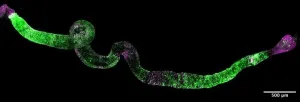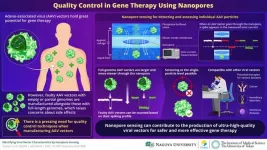(Press-News.org)
Researchers including those from the University of Tokyo’s Graduate School of Pharmaceutical Sciences transferred genes from simple organisms capable of regenerating their bodies into common fruit flies, more complex animals that cannot. They found the transferred gene suppressed an age-related intestinal issue in the flies. Their results suggest studying genes specific to animals with high regenerative capability may uncover new mechanisms for rejuvenating stem cell function and extending the healthy lifespan of unrelated organisms.
Do you want to live forever? Some do, some don’t. But we all want to live healthily for however long we have, and a big part of medical research is about this aspect of longevity. One idea, which might sound a little like science fiction, is to upgrade the human body in such a way that it can regenerate itself when injured, diseased, or when aging starts taking its toll, a bit like the superhero character Wolverine from the popular comic book and film series X-Men. Of course, we’re nowhere near that stage yet, but progress is being made in the world of regenerative medicine, albeit the test subjects are just flies for now.
“In animals capable of whole-body regeneration, such as flatworms and jellyfish, specific genes may help allow regeneration and maintain long-term stem cell functions. Conversely, mammals and insects, which have limited regenerative abilities, may have lost these genes during evolution,” said Associate Professor Yuichiro Nakajima. “It is unclear whether reintroducing these regeneration-associated genes in low regenerative animals could affect their regeneration and aging processes. In our recent study, we focused on the group of genes unique to animals with high regenerative capacity, named highly regenerative species-specific JmjC domain-encoding genes (HRJDs), and transferred them into the fruit fly Drosophila melanogaster, to test their effects.”
Nakajima’s team hoped upgraded fruit flies would regenerate tissue if injured, which didn’t happen. However, Hiroki Nagai, an expert in fruit fly intestines, noticed something else.
“Nagai discovered some novel phenotypes, characteristics that manifest from genes in a given set of conditions,” said Nakajima. “HRJDs promoted greater intestinal stem cell division, whilst also suppressing intestinal cells that were mis-differentiating, or going wrong in aged flies. This is in contrast to the use of antibiotics, for example, which might suppress mis-differentiated intestinal cells, but also suppress intestinal stem cell division. For this reason, HRJDs had a measurable effect on the lifespans of fruit flies, which opens the door, or at least provides clues, for the development of new anti-aging strategies. After all, human and insect intestines have surprisingly much in common on a cellular level.”
Finding this out was not without difficulties, however. Though fruit flies are famous test subjects for biological research, given their relatively short lives and fast rates of reproduction and maturation, their aging process still takes around two months, which affected the experimental schedules for Nakajima’s team, who were also busy with other things. Now that they have reached a striking conclusion, though, there is still much work to be done.
“Details of the molecular workings of HRJDs are still unresolved. And it’s unclear whether they work alone or in combination with some other component,” said Nakajima. “Therefore, this is just the start of the journey, but we know now that our modified fruit flies can serve as a valuable resource to uncover unprecedented mechanisms of stem cell rejuvenation in the future. In humans, intestinal stem cells decrease in activity with age, so this research is a promising avenue for stem cell-based therapies.”
###
Journal article:
Hiroki Nagai, Yuya Adachi, Tenki Nakasugi, Ema Takigawa, Junichiro Ui, Takashi Makino, Masayuki Miura and Yu-ichiro Nakajima. “Highly regenerative species-specifc genes improve age-associated features in the adult Drosophila midgut”, BMC Biology, DOI: 10.1186/s12915-024-01956-4
Funding: This work was supported by JSPS/MEXT KAKENHI (grant numbers JP22J01430 to H.N., JP21H04774, JP23H04766, JP24H00567 to M.M., and JP17H06332, JP22H02762, JP23K18134, JP23H04696 to Y.N.), AMED-Aging (JP21gm5010001 to M.M.), AMED-PRIME (JP22gm6110025 to Y.N.), and Sadako O. Hirai Ban Award for Young Researchers (H.N.)
Graduate school of Pharmaceutical Sciences - https://www.f.u-tokyo.ac.jp/en/
Research contact:
Associate Professor Yuichiro Nakajima
Graduate School of Pharmaceutical Sciences, The University of Tokyo,
7-3-1 Hongo, Bunkyo-ku, Tokyo, 113-8656, Japan
nakaji97@g.ecc.u-tokyo.ac.jp
Press contact:
Mr. Rohan Mehra
Public Relations Group, The University of Tokyo,
7-3-1 Hongo, Bunkyo-ku, Tokyo, 113-8656, Japan
press-releases.adm@gs.mail.u-tokyo.ac.jp
About The University of Tokyo:
The University of Tokyo is Japan's leading university and one of the world's top research universities. The vast research output of some 6,000 researchers is published in the world's top journals across the arts and sciences. Our vibrant student body of around 15,000 undergraduate and 15,000 graduate students includes over 4,000 international students. Find out more at www.u-tokyo.ac.jp/en/ or follow us on X (formerly Twitter) at @UTokyo_News_en.
END
Plant diseases pose significant challenges to agricultural productivity, presenting formidable hurdles that require urgent attention. Left unchecked, these diseases can spread rapidly, inflicting widespread damage on crops and leading to reduced yields and substantial economic losses. Therefore, accurately identifying the pathogens responsible for these diseases is crucial. This identification allows for targeted interventions that minimize risks and effectively mitigate the agricultural impacts.
Xanthomonas species are notorious plant pathogens that affect a broad spectrum of hosts, including key crops like rice, wheat, and tomatoes. These pathogens augment ...
The development of human societies is concurrent with infrastructural changes, evidenced by rapid urbanization in recent years. We are moving towards the era of 'smart cities' powered by advanced technology—such as artificial intelligence (AI), the Internet of Things, and big data analytics—for sustainable urban development. However, climate change has been hampering this growth—earthquakes and other natural hazards negatively impact buildings and other structures in their wake.
Soil liquefaction is an example of a natural ...
Over the past few decades, there has been remarkable progress in genetic manipulation technologies, bringing us closer to the point where genes can be modified in vivo. Such tools would open up the way to gene therapy, ushering in a new era in medicine. Thus far, the most promising strategies for gene therapy involve leveraging the existing molecular machinery found in viruses.
In particular, adeno-associated virus (AAV) vectors have recently garnered significant attention from the scientific community, given their potential to serve as nucleic acid vaccines ...
When developing new drugs, understanding their effects on ion channels in the body, such as the human ether-a-go-go-related gene (hERG) ion channel found in neurons and heart muscle cells, is critical. Blocking hERG channels can disrupt normal heart rhythm, potentially leading to a fatal condition known as torsade de pointes. Current methods for assessing these effects typically involve invasive procedures like patch-clamp techniques or fluorescence microscopy. These methods alter cell properties and may affect measurement accuracy, requiring specialized equipment ...
Much of the water in the West is transported across vast geographical areas by large infrastructure projects known as interbasin water transfers. Two of these projects in particular make up 85% of all energy-related greenhouse gas emissions associated with U.S. interbasin transfers — one in Arizona and the other in California — according to the new research published this week in the journal Nature Water.
The project in Arizona is known as the Central Arizona Project and in California it’s the State Water Project.
“You hear a lot about these big projects and how much energy they use,” said Avery Driscoll, a doctoral student in ...
Higher levels of urinary metals such as cadmium, tungsten, uranium, cobalt, copper and zinc are linked to increased cardiovascular disease and mortality in a racially and ethnically diverse U.S. population, according to a new study at Columbia University Mailman School of Public Health. While it is well documented that exposure to certain metals has been associated with cardiovascular disease (CVD) and mortality, until now the evidence was limited beyond arsenic, cadmium, and lead and for a racially diverse population. The findings are published in the journal Circulation.
When analyzed together, ...
Human-made climate change can lead to a destabilisation of large-scale components of the Earth system such as ice sheets or ocean circulation patterns, the so-called tipping elements. While these components will not tip over night, fundamental processes are put into motion unfolding over tens, hundreds or thousands of years. These changes are of such a serious nature that they should be avoided at all costs, the researchers argue. In their new study, they assessed the risks of destabilisation of at least one ...
For some forms of tuberculosis, the chances that an exposed person will get infected depend on whether the individual and the bacteria share a hometown, according to a new study comparing how different strains move through mixed populations in cosmopolitan cities.
Results of the research, led by Harvard Medical School scientists and published Aug. 1 in Nature Microbiology, provide the first hard evidence of long-standing observations that have led scientists to suspect that pathogen, place, and human host ...
LA JOLLA, CA—To diagnose heart conditions including heart attacks and heart rhythm disturbances, clinicians typically rely on 12-lead electrocardiograms (ECGs)—complex arrangements of electrodes and wires placed around the chest and limbs to detect the heart’s electrical activity. But these ECGs require specialized equipment and expertise, and not all clinics have the capability to perform them.
Now, a team of scientists and clinicians from Scripps Research has shown that heart conditions can be diagnosed roughly as accurately using just three electrodes and an artificial intelligence (AI) tool. In a ...
Current climate policies imply a high risk for tipping of critical Earth system elements, even if temperatures return to below 1.5°C of global warming after a period of overshoot. A new study indicates that these risks can be minimized if warming is swiftly reversed.
Human-made climate change can lead to a destabilization of large-scale components of the Earth system such as ice sheets, ocean circulation patterns, or global biosphere components, the so-called tipping elements. In their new study published in Nature Communications, researchers from IIASA and the Potsdam Institute for Climate Impact Research (PIK) analyzed the risks for four interconnected core climate tipping elements ...







